On February 21st, 2012 I was laid off from a job I fought hard to obtain, and fought hard to keep. The following day I went where many Brooklynites over the decades have gone for solace and to forget: Coney Island. I had lunch at Nathan’s, which is packed and jammed 7/365 no matter the weather. I was also there to photograph Coney Island’s dwindling collection of over a century-old trolley poles, which are somewhat endangered since recent construction has eliminated several of them.
Most trolley lines in Brooklyn vanished just a few years before I was born (in 1957–I know I should not reveal my true age lest I be written off as a prematurely out of touch and outdated crackpot, but sometimes it’s essential contextually). Mayor Fiorello LaGuardia, his successors, and NYC’s chief Regent and transportation czar, Robert Moses, were wedded to the notion of King Auto and the internal combustion engine, and buses had replaced trolleys in almost every case by 1956. A few trolley buses hung on in Williamsburg, Bedford-Stuyvesant and Bushwick until 1960, but these last Triceratops were at length replaced by the “new-look” GM fishbowl buses that were beginning to take command. When you think about it, NYC eliminated its trolley lines with a brutal and savage efficiency.
No fewer than three of Brooklyn’s trolley lines converged in Coney Island, at the same depot that now serves the D, F, N and Q subway lines. The #31 traveled from a large trolley terminal building (that’s still there) at 2nd Avenue and 58th Street south and southeast mainly by 5th Avenue, 86th Street and Stillwell Avenue; the #36 was an east-west route that traveled from Sea Gate to Sheepshead Bay along Surf Avenue, and the #73 was a special route I’ll describe later. And, if you count the Brighton Beach terminal that was south of Neptune Avenue and West 8th Street, the total number of trolley routes rises to seven.
According to Tricia Vita of the Coney Island blog Amusing the Zillion, trolley service began on Surf Avenue in 1893; service ended on the #36 Surf Avenue line on December 1, 1946. The Coney Island Chamber of Commerce petitioned the City Council to allow the poles to remain, without the catenary wire, so that holiday decorations could be easily run between them on a non-electric wire. And so, the poles have stood sentinel through Coney Island’s wave after wave of changes, its ups and downs, for nearly 120 years.
Of the 64 poles that were allowed to stand between West 5th and West 21st, we now have 43 poles remaining, as the Brooklyn Cyclones’ MCU Park construction and recent teardowns by Thor Equities claimed several. As the rust permeates them they will probably become unstable and will get torn down. They’re worth a look, if only to ponder what they have figuratively witnessed over the century.
A postcard view of Surf Avenue looking east from about West 16th, where Steeplechase Park was located. You can clearly see a pair of trolley cars plying the center of the street. The tracks were set amid Belgian blocks.
Surf Avenue looking east from the Loew’s Theatre at Stillwell Avenue in the Dirty Thirties. Just about everything in this photo has now been torn down, except for a couple of buildings on the south side (on the right) in the center, under the Cyclone, which is of course still there.
On the right, what looks like a cop on horseback crosses a kid on Surf Avenue. You can see a trolley car a couple of blocks ahead. All the guys wear straw hats. brooklynpix
In the early 1940s tracks pass by the Cyclone. From Stan Fischler, Confessions of a Brooklyn Trolley Dodger
A car picks up passengers outside the old BMT subway terminal at Surf and Stillwell. Note that you had to come out to the center of the street to get on. Today, you’d be steamrolled by the Surf Avenue would-be hot rodders. OK trolley fans, what make? Stan Fischler, Confessions of a Brooklyn Trolley Dodger
Surf Avenue looking East from West 12th. The old Luna Park, which was operated continuously in season from when it opened in 1903 to when it burned down in 1944, is on the left. A new Luna Park, which built an entrance gate that closely resembles the old one, opened on Surf Avenue’s south side in 2010.
Everything in this photo, except the trolley pole on the right, has vanished. brooklynpix
Kids heading for the beach cross Surf Avenue at West 15th in 1956. Surf Avenue has evolved. The trolleys have gone, but one pair of tracks has still not been paved over. The Loew’s is still showing movies (can you imagine a day at the beach, dinner at Nathan’s and a movie? You could do that once). Note the poles on the left and right. They’ve been painted kandy-kolored red, blue and yellow, and sheaves of flags are festooned on specially affixed holders.
The peaked roof in the center belongs to Henderson’s Dance Hall, which was torn down in 2010 and replaced with a one story bland structure. Nathan’s holds forth as it has since 1916. brooklynpix
This is the same pole in 2012, still bearing traces of the kandy-koloring.
Another trolley pole on the south side. Surf Avenue has become very wide open west of the amusement area, as a lot of buildings have been torn down with no replacements; there’s a lot of school bus parking lots.
MCU (Municipal Credit Union) Park, formerly KeySpan Park (when you have a corporate sponsor, the name of your ballpark changes every few years) is the home of the Class A Brooklyn Cyclones, an affiliate of the New York Mets. A statue outside the park, unveiled in 2005, recalls Dodgers shortshop Pee Wee Reese’ show of solidarity with Jackie Robinson when he broke the MLB color barrier in 1947, and was subjected to taunts and attacks from other players, especially ones from the South.
Outside MCU Park, all the trolley poles on the south side of the street were removed during construction, but resume at West 19th and continue to West 21st. The trolley poles west of that were presumably removed after the line shut down in 1946. The line continued to West 37th Street and the entrance to the private complex Sea Gate. West of here, Surf Avenue is dominated by drab high-rise people storage units.
A sentinel from the 1890s continues to oversee Surf Avenue in front of a particularly depressing old folks home.
Trolley poles, as a rule, unlike NYC’s cast iron lampposts from the 1890s and onward, are generally devoid of ornamentation or embellishment except for a top knob. Some poles were used to carry flags and still have the holders.
The bases have a slightly wider section. You can see the effects rust and sea spray have had. I see traces of a possible white paint job.
If you walk up a side street (this case West 17th) from Surf, just south of Mermaid, you find particularly lengthy driveways with the backs of buildings facing them. This is the route of the Nortons Point Trolley (#73), which left the Stillwell Avenue terminal via a rampway, descended to street level and continued in its own right of way all the way to the tip of Sea Gate via a shuttle trolley. Sea Gate originally featured a casino run by a fellow named Norton where the current lighthouse is located. His name has stuck all these years. The trolley ran until 11/7/1948, about two years longer then the Surf Avenue line.
While it was running, western Coney Island had a decidedly different, much more small-town atmosphere, before all the high rise monsters arrived in the 1950s and 1960s.
I don’t think any of the Norton’s Point trolley poles have survived but you never know.
An excerpt from a 1929 Belcher Hyde atlas of Coney Island. Note the black and white striped lines on Surf Avenue and the right of way: they depict trolley tracks. These maps are invaluable as a depiction of what was there in 1929, with everything down to the house numbers delineated, but of course, they’re a time capsule.
Shrine Church of Our Lady of Solace, Mermaid Avenue and East 17th Street. The parish has been in existence since 1901. The surprisingly thorough parish history contains an anti-Mosesian narrative:
Over the decades, the destinies of the Shrine Church of Our Lady of Solace and America’s Playground would be inevitably intertwined. Coney Island lost Dreamland to a massive fire in 1911. In 1944, Luna Park from Surf Avenue to Neptune Avenue suffered the same fate. The surviving section of the park from Neptune Avenue to the subway yard continued to operate for the remainder of the season; then it, too, closed. During the decades of the fifties, sixties and seventies (the era of Robert Moses’ much-
Through the longtime devotion and generosity of the Tilyou family to the Shrine Church of Our Lady of Solace, they were restored that spring in time for the annual “Catholic Day.” However, the escalating crime and gang violence, as well as the overwhelming competition from Robert Moses’ 1964 New York World’s Fair was too much to overcome and the great “funny place,” Steeplechase, closed forever. Moses’ triumph was complete; he had successfully helped eliminate the last of the three great Coney Island theme parks. At the moment of its closing, two bells sounded that indicated the passage of time, and the numerous lights went out for the last time. In 1965, the Tilyou family sold the park to developer Fred Trump, who then subleased some of the property to small independent ride operators and concessionaires…
In 2000, the abandoned Thunderbolt was suddenly condemned and demolished by the City Buildings Department as “unsafe” on the orders of Mayor Rudolph Giuliani (he saw it an “eyesore” next to the new Keyspan Park), just before the City Council was about to meet with property owner Horace Bullard and consider landmark status and funding for restoration and new operation. Fortunately, were two bright spots that kept classic amusements from leaving Coney Island forever in spite of the City’s efforts to wipe them out completely. One was the establishment of Astroland Park in 1962, built on the site of the old Feltman’s Hot Dog Emporium, by Dewey and Jerome Albert. The Albert family later took over management of the National Historic Landmark Cyclone rollercoaster in 1974 after it was purchased by the City of New York. The other was when Tarrytown pushcart vendor, entrepreneur, restaurateur, and very frequent Coney Island vacationer Denos Vourderis purchased and saved the former Ward’s Kiddie Park in 1981.
Give that link a look — it definitely highlights the recent history of Coney Island in a refreshingly pointed manner.
At the northwest corner of Surf Avenue and West 16th is the last vestige of the Seven Seas Restaurant, now a parking lot.
Directly in front of it is a snapped-off trolley post.
The present set of Nathan’s red, green and yellow neon signs have been in use since at least the 1950s. Though Nathan’s is now thought of as a fast food place, the Coney Island flagship has the most varied menu, offering a large range of seafood from clams to frog legs. As you can see on the sign, it’s still identified as a delicatessen. In recent years, Nathans has attracted national attention every 4th of July for its famed hotdog eating contest.
Remember the photo above of Surf Avenue and West 12th? Here’s the trolley pole, the only thing remaining from the photograph. Discount furniture stores have replaced the carousel and the old Luna Park; the Houses named for the park form the backdrop.
This 1917 building at Surf and West 12th was originally a Child’s Restaurant and today is home to the Coney Island Museum and Sideshows By the Seashore, a taste of Coney Island’s old sucker-born-every-minute atmosphere.
Affixed to the building are works by Coney Island’s first lady of poster art, Marie Roberts.
Born and raised in Coney Island, Marie’s family has had strong ties to the community for several generations and her art reflects this deep bond with the landscape. She says that her “father’s family was involved in Coney Island at the turn of the 20th century; my grandfather was acting battalion chief of the Coney Island District until his death in 1924. My Uncles Harry and Guy were at Dreamland the night of the fire. I have an uncle buried in the Gravesend Cemetery. My father claimed he never got out of the 6th grade because he was too busy watching the horses cross the finish line at the Gravesend track. My Uncle Lester was the talker for the Dreamland Circus Sideshow in the 1920’s.” For the Love of Brooklyn
In front of the new Luna Park and Cyclone, the old trolley poles have been put to work carrying electric wire and sidewalk spotlights, and a new red, white and blue paint job in the order of the former red, yellow and blue.
The Cyclone rollercoaster, which I have never ridden since I am a sniveling coward, has been part of the Coney Island scene fro 9 decades. The Dewey Albert on the street sign is the owner of the famed Astroland amusement park, of which the Cyclone was a part from 1962-2008. The Cyclone was declared a NYC Landmark in 1988 — the Thunderbolt, opposite the old Steeplechase Park, wasn’t, which enabled its decline and destruction by the city in 2000.
The success of 1925’s Thunderbolt and 1926’s Tornado led Jack and Irving Rosenthal to buy land at the intersection of Surf Avenue and West 10th Street for a coaster of their own. With a $100,000 investment, they hired Vernan Keenan to design a new coaster. A man named Harry C. Baker supervised the construction, which was done by area companies including National Bridge Company (which supplied the steel) and Cross, Austin, & Ireland (which supplied the lumber). The Cyclone was built on the site of America’s first roller coaster, known as Switchback Railway(which opened on January 16, 1884). The final cost of the Cyclone has been reported to be around $146,000 to $175,000. When the Cyclone opened on June 26, 1927, a ride cost only twenty-five cents compared to the $8.00 in the 2011 season. wikipedia
In the background we can see one of the two Brightwater Towers, a high rise constructed in the 1960s.
The only rollercoaster I ever rode was a relatively modest one indoors at the Mall of America in Minneapolis in 1993. I didn’t particularly enjoy it and got none of the thrill rollercoaster fans get on these things, but don’t let me stop you.
Double-barrel elevated train action north of Surf Avenue and West 10th. Because of track capacities at the Stillwell terminal, the express Brighton (the B) makes its last stop at the West 8th Street station. In the background are the Luna Park Houses, built behind the old amusement park locale.
The last pole remaining as you go east on Surf Avenue is at West 5th Street and Asser Levy Park. Older maps show it as Seaside Park, one of Coney Island’s oldest, having been acquired as parkland in the 1880s. It was renamed for one of the first Jewish settlers in New Netherland: he and his associates arrived as refugees from Brazil in 1654. Levy became the first Jew to own real estate in North America. The park is famed for its Seaside Summer Concert series; attractions in the 2011 series included Aretha Franklin, Joan Jett, and the Monkees, with Davy Jones making one of his final appearances.
These poles were removed in the summer of 2019.
3/4/12

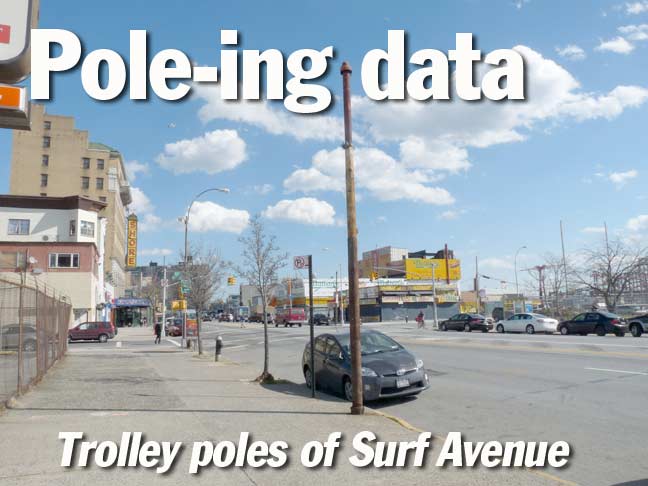

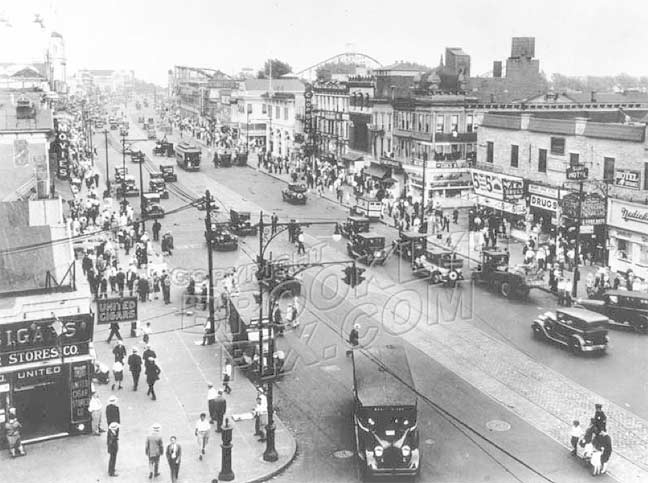
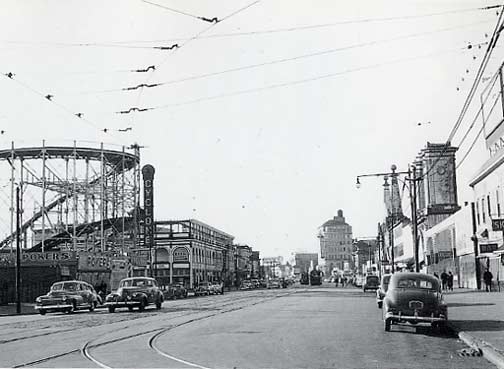
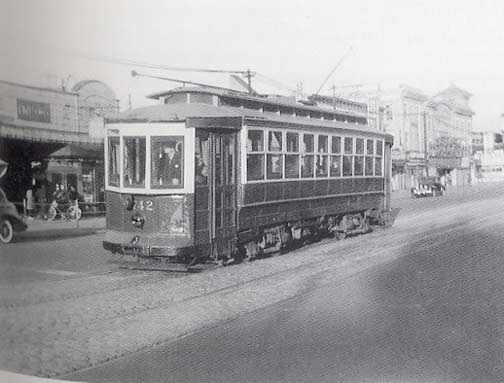

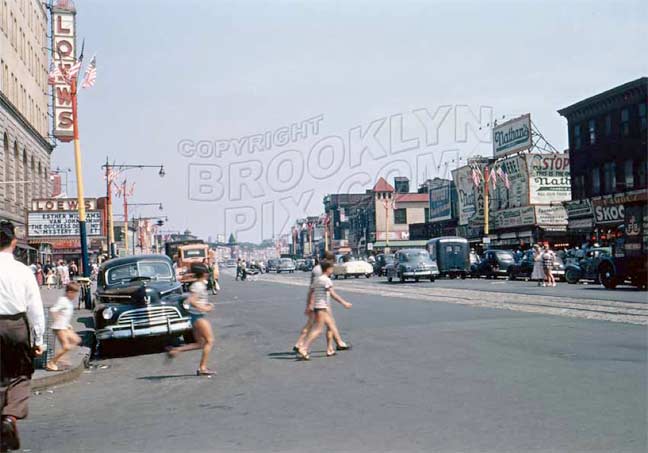
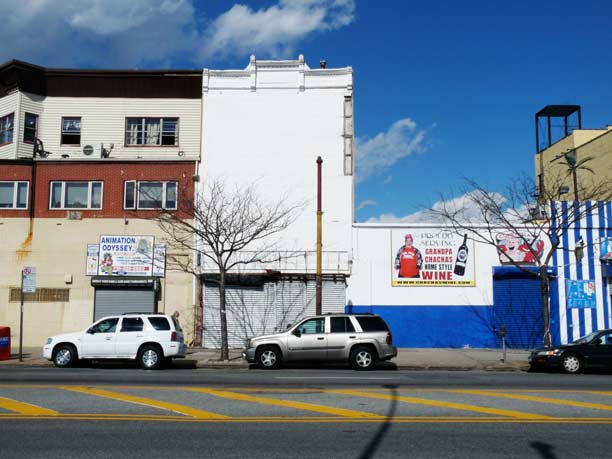







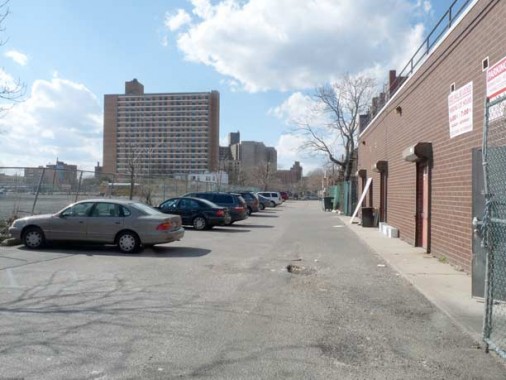
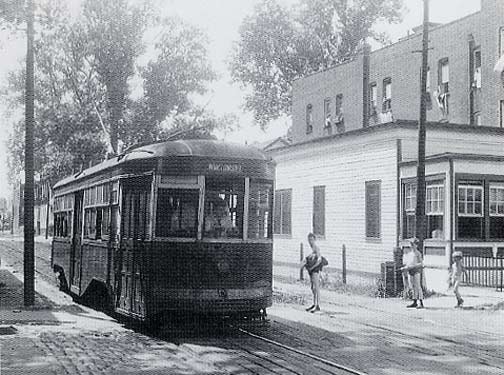


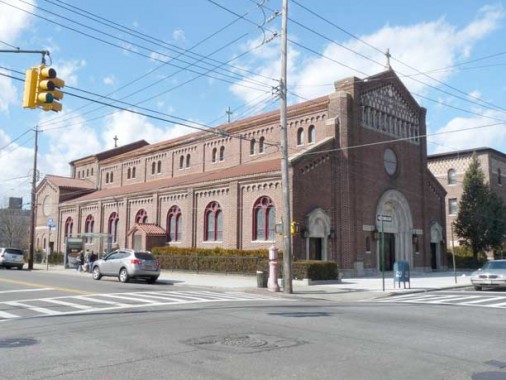




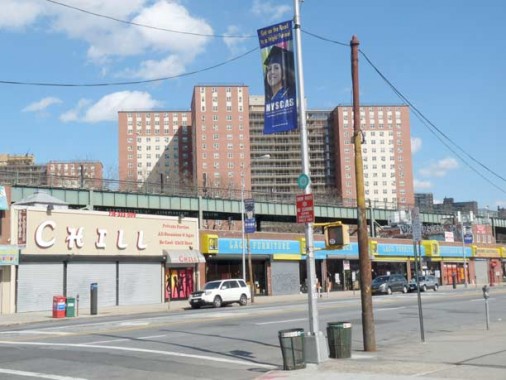

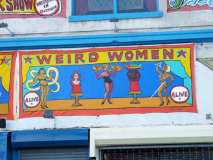
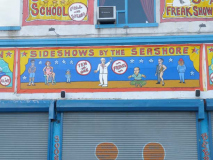
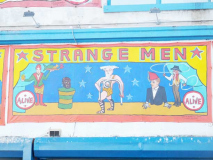
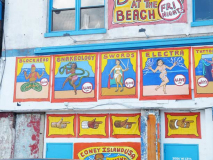
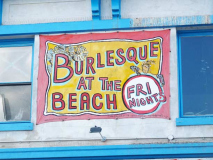
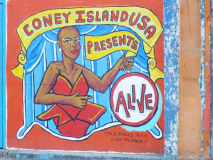




42 comments
I am very sorry to hear of your layoff, Kevin. Great job on the trolley poles! I wish they were still around, or at least revived in the City!
I’m sorry to hear that for the second time in about 2 years you’ve become unemployed. You’d think that in The Era of BO, all the red diaper babies & green geniuses could create a job for you. Perhaps you could build a wind powered trolley line or a solar paneled “hybrid” windmill or some other patronage driven scam. The calendar may say 2012 but it feels like “1984” (the OIrwell novel, not the actual year, which upon reflection, was pretty good).
Companies are less willing to let you learn on the job, let’s put it that way.
companies don’t call you back when they say they will, much less let you learn on the job
Having been born and raised in Coney Island (and not living too far away today) I was pleased to see your piece on the Trolley Poles still extant. I remember as a small child being taken by my father for a ride on the last trolley line in Brooklyn. The trolley barn was under the tracks near West 8th street. This was in the early 50’s. You should note that the “right of way” marked on the map was a named street between West 19th and West 21st street (there is no West 20th). It was called Railroad avenue and my father was raised on that street. I have his WW2 dog tags with the address 1918 Railroad Avenue on them. Also The “B” train terminates at Brighton Beach, not West 8th street! Still thanks again for the nostalgia trip.
I’m a bit thin on Railroad Avenue. Was the whole ROW briefly converted to a street called Railroad Avenue, which turns up on 1950s maps, and then later closed?
Don’t know for sure, but my father was in the US Army in the 1940’s and I was born in ’51. Another story I remembered was my father telling me when he was young he and my uncle would put one cent pieces on the trolley track and the passing trolley would flatten them and they could be used in the subway turnstiles!
Another story was that Mr. Tilyou, owner of Steeplechase Park would pray for rain at Our Lady of Solace (My parish) as his was the only park that was covered! Hope this helps.
Hi Tony:
The story about the penny is true, I did it myself.
Kevin, Sorry to hear about the job. Life in this market is tough. I just finished a graduate program but I won’t jump from my current job until I actually find something. And of course people of our age can have a hard time finding an employer willing to hire. I was born in ’52.
The two places I loved as a kid were Coney and Jones Beach. For years I held onto a straw hat from Coney Island. Before it was demolished I took a bunch of pictures of the old Thunderbolt Coaster. I still haven’t been on the Cyclone, maybe on my next trip to the city. I live in Florida now and have ridden the coasters at Busch Gardens many times and I figure it is about time I rode a classic old coaster. Would you be interested in joining me?
That’s funny you mentioned Jones beach. I was born and raised on Long Island and my mother would take me to the beach every Saturday. I loved going and looked forward to going. Now I live south of Pittsburgh, PA and the last time I was at Jones Beach was in 2001. I remembered my mother used to like to park in Lot 2 because it was closest to the water. So when I went back to Jones Beach I parked in Lot 2. I didn’t remember having to pay to get into Jones Beach when I was little but you have to pay now. One time my Aunt who lived in East Islip, wanted us to go to Robert Moses Beach. Me and my mother didn’t like that beach. We both said it was too dirty and too much seaweed in the water. Oh and one time my mother took me to Jones Beach all the lots were full except for Zach’s Bay. I hated it there. I was digging in the sand and just under the sand was black soil. Yuck! By the way, I was born in 1952.
Good luck with the job search, Kevin. The economy is improving, and you have a network of loyal FNY fans. My family used to take the McDonald Ave. trolley from Ave. I to Coney Island until it shut down in the mid-50’s. The “D” train ran overhead, but the trolley was more fun (if you watched for cars when you got off)! Funny, when I left Brooklyn in the late 60’s, we were in a “Cold War” with the Russians. By the time I returned for 2 years of studies at Coney Island Hospital in the mid-90’s, the Russian’s had successfully “invaded” Brooklyn without firing a shot! Go figure…
Kevin, sorry to hear about your job situation. Remember that every closed door is an opportunity to open another one! Greatly enjoyed this week’s installment. Been going to Coney since the early 60’s. I was always a bigger fan of Thunderbolt over the Cyclone. You’ve got to ride it at least once! We could have a forgotten NY fan outing to encourage you. Peace.
That’s a great idea! It would be great to have a get together some place! I would go!
I too am sorry to hear about your job trouble, having just got over a bit of it myself a few months ago. Hang in there.
My family moved to Manhattan Beach in 1985 and I attended Mark Twain Junior High School from 1986-1989, on Neptune Avenue and (I think) W. 25th Street. Back then Coney Island was quite a scary place for a 12 year old.
Starting in 1989 I attended Lincoln High School at West St. and Ocean Parkway…slightly better neighborhood but school administration still barely let us even go outside!
Throughout that time I would ride my bike with my Dad to the Boardwalk, all the way down to Sea Gate. It was like riding through another world. So many relics left back then from times that didn’t seem so long ago. Not like now.
And all that time not once did I ever notice the trolley poles! Thanks for putting this together.
Kevin: I hope your period of unemployment is a short one and that one of your many fans (a group of which I am a member) can open a few doors. Your photos of Coney Island trolley poles brought back many memories. I grew up in Coney Island in the 1950s and 1960s and lived a block away from Railroad Avenue, which by that time looked like an abandoned alleyway between Mermaid and Surf Avenues. My father owned a small furniture and floor covering store on W. 16th Street and Mermaid Avenue, just around the corner from the Seven Seas whose sidewalk entrance you photographed. While far from its heyday, Coney Island at that time was a working class and lower middle class neighborhood, mostly Jewish and Italian, but with a mix of others. Bensonhurst, Sheepshead Bay and other nearby communities were higher up on the socioeconomic scale, but even in the late 1950s people left doors unlocked and crime was relatively rare. By the late 1960s, Robert Moses, who was hellbent on “modernizing” Coney Island, had demolished most of the two- and three-family houses in the area between the amusement parks and Sea Gate and erected low-income high-rise projects that soon became worse slums than the low-rise private (and tax-paying) housing they replaced. While so much of Brooklyn has gentrified or become attractive again to the middle class, Coney Island remains a forlorn outpost. It has great transportation, the ocean, parks — yet only in New York does such prime real estate (like its sister potential oceanfront gem, the Rockaways) serve as a warehouse for the poor. Once “urban renewal” has done its dirty work, it seems almost impossible to reverse it, but when the current buildings are demolished in 50 or 75 years, perhaps future generations will recognize the folly of what happened and come up with smarter ways to make the most of a unique resource.
Once again Robert Moses is demonized. This time for building low income housing. It’s the occupants that destroy their neighborhood not the builder.
Robert Moses was a wanton destroyer of neighborhoods. Read “The Power Broker: Robert Moses and the Fall of New York”, an 1158 page biography about him written by Robert A. Caro. Read that first and *then* tell me he didn’t destroy solid lower middle and middle class neighborhoods with a vengence.
Moses also literally drove the Dodgers out of Brooklyn. Although O’Malley is vilified he wanted to remain in Brooklyn but the Board of Estimate would not use Eminent domain to assemble properties to construct the new Dodger Stadium at Atlantic and Flatbush which now is Barkley center.
Once again Robert Moses is demonized
I thought Robert Moses built highways and not housing projects.
Great story. Stan is a friend of mine – I exchange email with him about trolleys, subways, and hockey. He’s also a NYC historian – perhaps you can collaborate on a book, which would be more fun than working for a company !
Jonathan
Yes, I think another book is order Kevin! Need to add stables this time! ;-p
Sorry to hear about your job loss. When one door closes another opens. When I lost my job of 25 years, I started my own business. Why I waited and worked for someone else for 25 years I’ll never know!
Still hoping to earn enough from FNY. I will be adding photo sales soon.
sorry to hear of your job situation, but optimistic that you’ll soon be on the high road… remember that your friends out here in internet-land appreciate you and think of you lots. i wish you had a piece covering st john’s place and a long lost hospital that i remember in brooklyn (unity hospital)
best wishes and happier times to you…
Kevin, Your Forgotten-NY website is great, This is your resume and cover letter all rolled into one.
You’ll no doubt have little trouble landing a dream job in your field. Keep up the good work.
Sorry to hear of your layoff. A great article. Thank you
Inside Seagate, there still trolley poles standing being used to display stop signs for traffic control. They seem to be in very good shape.
Kevin,
Wow! I have been to Coney Island a billion times and not once did I ever notice the trolley poles! Thanks for bring this to my attention. Nathan’s, here I come…………
Hope all is well!
Gary Owen
Beautiful exploration of historic Coney Island- and fascinating piece on the glory days of trolleys!
[begin pedantic cuntery]Actually-factually, trolley poles are the ‘spring-based tapered cylindrical poles used to transfer electricity from the overhead live wires to the trolley’ (wiki ref.) They were a part attached to the trolleys. Sadly, there are no remaining trolley poles in Coney Island, unless they exist with the trolleys in museums. I don’t know what the word for these trolley wire posts is; anyone have information on that? [/end pedantic cuntery] 🙂
[…] article excerpts courtesy of Forgotten NY: According to Tricia Vita of the Coney Island blog Amusing the Zillion, trolley service began on […]
Wonderful and insightful reflection upon the glory days of not only the trolleys of Brooklyn, but of the great mass transit system upon which the original City of Brooklyn was built and upon which the Borough of Brooklyn originally thrived. Those were the days before the deep-pocketed General Motors paid New York’s politicians to appoint so-called transportation experts to destroy the BMT and its constant innovations in transit (used all over the world but abandoned in New York City. Ironically, the worst of the villians in that respect was probably its most beloved mayor, Fiorello LaGuardia (who, with Robert Moses, was always photographed smiling as another trolley line and el closed and shaking hands with GM executives as more gas and diesel buses clogged the streets over the objections of 97 percent of Brooklyn residents). Sadly, the lack of modern mass transit foresight was LaGuardia’s blind side, and it has been a costly one to Brooklyn.
I want to also mention another trolley pole that survived, although a bit tipsy. It’s located on the northwest corner of Mermaid and Stillwell Avenues in front of the old Kensington Hotel site that is now occupied by a McDonald’s. The Mickey D’s is temprarily closed due to enormous damage from the Superstorm Sandy ocean storm surge, but the trolley pole still stands firm.
Kevin,
I hope by now you’re employed. I enjoyed your story and then saw there was a San francisco post. That is my hometown (born 1950) now in NJ. I remember when back in the 50’s and 60’s, Muni (SF’s Transit Auth.) wanted to get rid of not only the streetcars, but even the cablecars (tourism stopped that). What saved the steetcars was (luckily) the 2-1/2 mile Twin Peaks tunnel was not quite wide enough for buses. If you were there after 1980, it is amazing what was done. It is now light rail trains and they enter the tunnel and then are a subway all the way downtown – except for the Ballpark at the end. Although from what I read on MuniDiaries, it does not operate as great as it should. Then in the mid nineties, they started running the F Line of historic streetcars on Market Street above the subway and BART , and it actually may have passed the cablecars in popularity. One last thing — when the trains enter the subway, they are computer operated..
No job yet. Any suggestions?
don’t move to Las Vegas
Loved the article. My Grandmother resided at 2933 W 16th St across from “Frank” The Barbers and the Seven Seas. My Aunt (E.C. Hall) used to park her car in the parking lot behind The Tilyou Theater and later near Moll;y and Freddy Morans residense under the Thunderbolt. Ate at Garguilio’s numerous times. and walked up th Bevelack’s Clam Bar on Surf Ave to buy my Father his Chesterfields from the Cig Machine..
In this article, we will discuss three variants, ranging from the sort
of model you might start out with as a beginner to the elaborate scale models you might aspire to fly one
day. There is an remote control helicopter to fit almost every budget and need.
Since it has a built-in rechargeable batter there is
no cord for you to have to hide or deal with.
This is the first time I have been to this site. I found it by accident but am enjoying this site. I thought it was a sad story about Coney Island. It’s a shame things can’t stay the same. I never have been to Coney Island. I lived on Long Island in Nassau County. My mother was from Ridgewood, Queens. I have her old autograph book from when she graduated from the 8th grade and there is a picture of her old school in it. Anyway, one time when I was in elementary school, we went on a field trip to an inside petting zoo which was right across from Coney Island. I don’t remember the name of the petting zoo. They had llama’s in there. You bought a cone shaped container of food to feed the animals. I fed one of the llama’s and got another cone of food. I was standing next to the llama and was looking around to see which animal I would go see and that llama stold the container of food right out of my hand and ate the food. I was so mad because I didn’t have anymore money to buy more food! We moved some when I was living on Long Island but the last town I lived was Elmont. I used to love going to Zappienza’s bakery. I’m probably not spelling it correctly but I really loved their cannoli. I also remember the hot dog stands. I loved those Nathan’s hot dogs they sold. Back in 1972 I think they only cost like 35 or 45 cents. I loved the crunchy skin on those hot dogs. Where I live now they don’t have good food that NY offers. It’s all so bland. When I lived in NY potato and macaroni salads sold at the deli didn’t have eggs in them. When I moved to where I live now everyone puts eggs in them and when I went back to NY in 2001 I went to a deli in West Hempstead and I see they had eggs in their potato salads. I don’t like eggs in my salads. Oh and you know what else I miss? Does anyone remember Health Salad? I love that stuff! And there is no place where I live that can make a real NY pizza! They might say NY pizza here but I don’t know what they think a NY pizza is! I also miss italian cheesecake. You can’t buy that here. The only cheesecake they know how to make here is with cream cheese. I like the kind with the ricotta in it. Yeah things change. Neighborhoods change. People change. I now know what it means when they say, “You can never go home.”
Hi Kevin:
I really enjoyed your article and really can connect to everything.
I was born at the original Coney Island hospital on 12/20/42. I had my first communion at Lady of Solace Church. Steeplechase and Raven Hall pool were my playgrounds and in the winter we played a game called king of the Cyclone, several of us armed with sticks and rocks would race to the top of the first hill. The first one to the top got to throw the sticks and rocks at the others to keep them from advancing.
I remember buying hot dogs at Nathans for 10 cents and spreading mustard on them with the wooden sticks in the giant bowls of mustard on the counter.
I tell people that I have Coney Island in my blood and they look strangely at me, then I explain how on numerous occasions I fell on the tracks of the Cyclone and got many splinters from the wood that held the tracks.
I lived on Stillwell Ave. and could see Nathans from my building. I used to hitch rides on the Stillwell Ave. trolley car by hanging on the back. My cousins owned the Riviera Catering hall. The land on the west side of the Stillwell Ave. bridge was my Grandfathers farm.
I am in the process of writing a screenplay about my Grandfather and the fascinating life he lived.
If you read this I would love to chat with you or anybody else with Coney Island ties.
If by chance any of my childhood friends John and Kathleen Bennett, Bobby Rapasarti, Marty, Buddy or anyone who grew up on Stillwell Ave. in the 40’s please contact me.
My number is 407 384 8913.
bronzedepot1@aol.com
We have an Allan Herschell Carrousel from Coney Island, NY. We have a picture of it on a street there dated 1965. It shows a picture of a Safeway Supermarket in the background and a checker cab on the street outside of a chain link fence. We were interested in finding more information about our carousel. It has been in our family since it was purchased from Coney Island and used continuously until four years ago.
If anyone has some information about the area in 1965 and might know the location, I have the picture and would be interested. My email z28rag@cfl.rr.com
I LOVED EVERYTHING I READ ABOUT CONEY ISLAND, AND THE HISTORY OF HOW EVERYTHING UNFOLDED, FASCINATING STORY, THAT I WOULD LOVE TO SHARE WITH SO MANY FRIENDS. I GREW UP IN CONEY ISLAND, AND I LOVED IT THERE, AND STILL GO THERE ALL THE TIME, IT WAS MY HOME, MY BEST MEMORIES ARE FROM CONEY ISLAND, THE FRIENDS I MADE THERE, ARE STILL MY FRIENDS TILL THIS DAY. THERE WAS NO PLACE LIKE CONEY ISLAND, THE RIDES, STEEPLECHASE, ALL THE MOVIES, ANIMAL NURSERY, SO MANY GAMES TO PLAY, AND OF COURSE THE BEACH!! THERE WAS ALWAYS SOMETHING TO DO THERE, I NEVER REALLY HAD TO LEAVE CONEY ISLAND WHEN I WAS A KID, WE HAD EVERYTHING THERE. EVERYONE I MEET HAS A STORY ABOUT CONEY ISLAND, AND GREAT MEMORIES TO SHARE, NO MATTER WHERE THEY LIVE NOW, CONEY WILL ALWAYS BE IN THEIR HEART, LIKE IT IS IN MINE. I WOULD LIKE TO THANK YOU FOR WRITING SUCH AN AMAZING STORY ABOUT CONEY ISLAND, AND FOR ALL THE GREAT PHOTOGRAPHS. IF THERE IS A WAY TO SHARE THIS TO ME, I WOULD GREATLY APPRECIATE IT. THANK YOU!! P.S. I LOOK FORWARD TO READING MORE OF YOUR ARTICLES, AND STORIES!!!
Sad update about the Trolley Poles on Surf Ave in Coney Island, Starting this summer (2019), they cut down 2/3’s of the height of all the trolley poles. At the end of the summer, they removed them totally. The only reason i heard was from the Chairman of Community Board 13. While the vast majority were in good condition (my opinion), a couple had issues. At the ground, the only thing connecting them to the ground was the interior rebars. The cement and the outer casing deteriorated and was gone. The nearest official reason given technically no one maintained them, so they had to be removed. Department of Transportation removed them all.
Thank you for all this wonderful and enjoyable
information on the trolleys and Coney Island.
I remember as a child, our taking the trolley in
the Bronx where we lived and changing over to
another one as the destination was Coney Island.
It was a very long trip but we enjoyed every moment
of this trip! It was a mini vacation for myself and
my two brothers! And thanks for taking the time
to give us the history of the poles and also the links
to other exciting sites. As a native New Yorker, I’m
always interested and excited to read about my
beloved city. I live down south now, but in my heart
and mind, will always remain a New Yorker